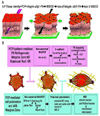Integration of planar cell polarity and ECM signaling in elongation of the vertebrate body plan
- PMID: 20739170
- PMCID: PMC4510957
- DOI: 10.1016/j.ceb.2010.07.012
Integration of planar cell polarity and ECM signaling in elongation of the vertebrate body plan
Abstract
The shaping of the vertebrate embryonic body plan depends heavily on the narrowing and lengthening (convergence and extension) of embryonic tissues by cell intercalation, a process by which cells actively crawl between one another along the axis of convergence to produce a narrower, longer array. We discuss recent evidence that the vertebrate non-canonical Wnt/Planar Cell Polarity (PCP) pathway, known to directly function in polarizing the movements of intercalating cells, is also involved in the localized assembly of extracellular matrix (ECM). These cell-ECM interactions, in turn, are necessary for expression of the oriented, polarized cell intercalation. The mechanism of PCP/ECM interactions, their molecular signaling, and their mechanical consequences for morphogenesis are discussed with the goal of identifying important unsolved issues.
Copyright © 2010 Elsevier Ltd. All rights reserved.
Figures




Similar articles
-
FGF3 in the floor plate directs notochord convergent extension in the Ciona tadpole.Development. 2009 Jan;136(1):23-8. doi: 10.1242/dev.029157. Epub 2008 Nov 26. Development. 2009. PMID: 19036800 Free PMC article.
-
Chongmague reveals an essential role for laminin-mediated boundary formation in chordate convergence and extension movements.Development. 2008 Jan;135(1):33-41. doi: 10.1242/dev.010892. Epub 2007 Nov 21. Development. 2008. PMID: 18032448 Free PMC article.
-
A one-dimensional model of PCP signaling: polarized cell behavior in the notochord of the ascidian Ciona.Dev Biol. 2014 Nov 1;395(1):120-30. doi: 10.1016/j.ydbio.2014.08.023. Epub 2014 Aug 28. Dev Biol. 2014. PMID: 25173874 Free PMC article.
-
Regulation of convergence and extension movements during vertebrate gastrulation by the Wnt/PCP pathway.Semin Cell Dev Biol. 2009 Oct;20(8):986-97. doi: 10.1016/j.semcdb.2009.09.004. Epub 2009 Sep 15. Semin Cell Dev Biol. 2009. PMID: 19761865 Free PMC article. Review.
-
Shaping the vertebrate body plan by polarized embryonic cell movements.Science. 2002 Dec 6;298(5600):1950-4. doi: 10.1126/science.1079478. Science. 2002. PMID: 12471247 Review.
Cited by
-
Bridging structure and process in developmental biology through new imaging technologies.Dev Cell. 2011 Jul 19;21(1):5-10. doi: 10.1016/j.devcel.2011.06.030. Dev Cell. 2011. PMID: 21763598 Free PMC article.
-
Filamin A- and formin 2-dependent endocytosis regulates proliferation via the canonical Wnt pathway.Development. 2016 Dec 1;143(23):4509-4520. doi: 10.1242/dev.139295. Epub 2016 Oct 27. Development. 2016. PMID: 27789627 Free PMC article.
-
Complex structures from patterned cell sheets.Philos Trans R Soc Lond B Biol Sci. 2017 May 19;372(1720):20150515. doi: 10.1098/rstb.2015.0515. Philos Trans R Soc Lond B Biol Sci. 2017. PMID: 28348251 Free PMC article. Review.
-
Planar cell polarity signaling in collective cell movements during morphogenesis and disease.Curr Genomics. 2012 Dec;13(8):609-22. doi: 10.2174/138920212803759721. Curr Genomics. 2012. PMID: 23730201 Free PMC article.
-
Planar cell polarity in kidney development and disease.Organogenesis. 2011 Jul-Sep;7(3):180-90. doi: 10.4161/org.7.3.18320. Epub 2011 Jul 1. Organogenesis. 2011. PMID: 22027435 Free PMC article. Review.
References
-
- Shih J, Keller R. Cell motility driving mediolateral intercalation in explants of Xenopus laevis. Development. 1992;116:901–914. - PubMed
-
- Ninomiya H, Elinson RP, Winklbauer R. Antero-posterior tissue polarity links mesoderm convergent extension to axial patterning. Nature. 2004;430:364–367. - PubMed
-
- Wallingford JB, Rowning BA, Vogeli KM, Rothbacher U, Fraser SE, Harland RM. Dishevelled controls cell polarity during Xenopus gastrulation. Nature. 2000;405:81–85. - PubMed
Publication types
MeSH terms
Substances
Grants and funding
LinkOut - more resources
Full Text Sources

